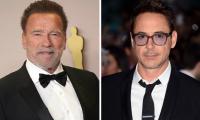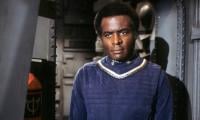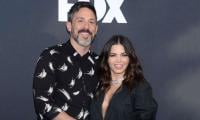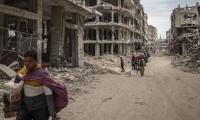Michael Brown Sr lies stock-still on his back on the floor of an art studio in St Louis as an artist layers papier-mache on his arms, chest, and torso.
Brown Sr is a stand-in, the model for a life-size replica that St Louis artist Dail Chambers is creating to represent Michael Brown Jr – his deceased son.
In the days and weeks that followed, other artists added their own interpretations to the cast, and community leaders, family, friends, and activists affixed messages of remembrance, of hope, as well as photos and tributes to Brown Jr.
The final exhibit, called 'As I See You', were part of a memorial Aug 9–11 for Brown Jr, five years after a police officer took the 18-year-old’s life in Ferguson, Missouri. The memorial weekend’s events included a private unveiling of the exhibit for the family members of 25 victims of police killings across the country, and will coincide with the first national reparations convening in Ferguson, beginning Aug 8.
Brown Jr was not the first unarmed Black man killed by a White police officer. But his death on Aug 9, 2014, grabbed the world’s attention, exposing long-festering issues of race and inequality in the United States and bringing new energy to a simmering Movement for Black Lives.
In death, Brown Jr became a household name, and the small, mostly Black city where he died became the movement’s ground zero. Both will be forever linked to the tragedy and trauma around police shootings and the will of a frustrated people to rise up against injustice. For more than four hours, Brown Jr’s lifeless body lay uncovered on the street where he fell, blood flowing from his head as bystanders watched in horror and outrage. For weeks following the shooting, and months after a St Louis grand jury failed to indict officer Darren Wilson, protests and demonstrations engulfed the region.
Images on television and on social media caught the sporadic violent clashes between demonstrators and police, who used tear gas and armored vehicles intended for war zones to try to control the crowds.
“People, protestors were coming in from all over … coming to ground zero to stand up for what they believed in,” Brown Sr. says. “We are so grateful to them for making this happen, for having the courage to know it was wrong and to stand up for their beliefs. Before Mike, this kind of thing was mostly swept under the rug; now it’s happening almost all the time.”
The Ferguson Uprising raised awareness around the level of racial disparity on issues from policing and mass incarceration to economics – not just in that region, but across the country.
And in the months and years afterward, protests and demonstrations elsewhere would follow police shootings of other Black people whose names many have now come to know: Philando Castile, Tamir Rice, Freddie Gray, Eric Harris, Terence Crutcher, Walter Scott, Sandra Bland, Antwon Rose, and on.
Excerpted from: 'Five Years After Ferguson Uprising, Still Seeking Justice and Healing'.
Courtesy: Commondreams. org
A health worker administers polio vaccine drops to a child during a door-to-door polio vaccination campaign in Lahore,...
Armed militants of the banned Tehreek-e-Taliban Pakistan pose for a photograph in Orakzai Agency. —...
An aeroplane of the national flag carrier of Pakistan is seen in this file photo. — AFPWhile Pakistan considers...
Representational image of a graph depicting various variables. — APP/FileInitiated by the centre and fiercely...
In this picture taken on April 16, 2023, people throng a market area during shopping in Lahore. — AFPOne of the...
Honour crimes also target men. In Sikandar Ali Lashari vs The State, SHC upheld conviction passed by ATC for honour...







